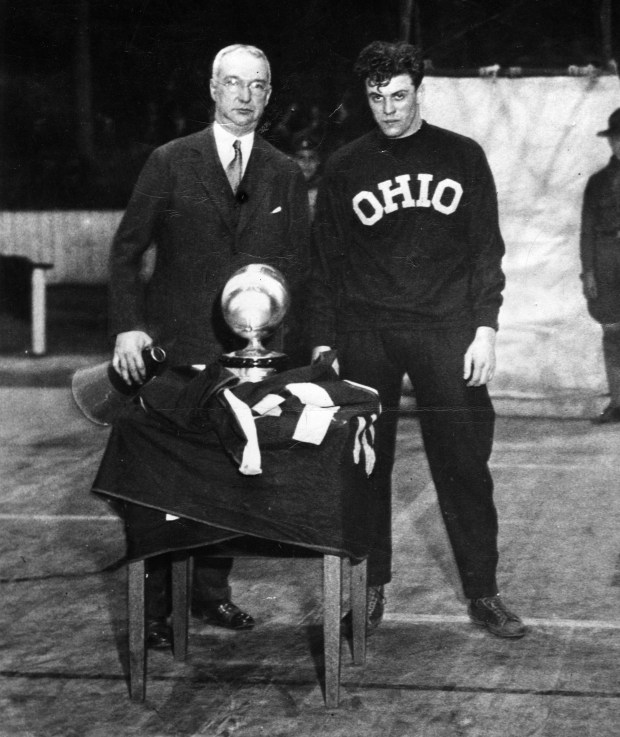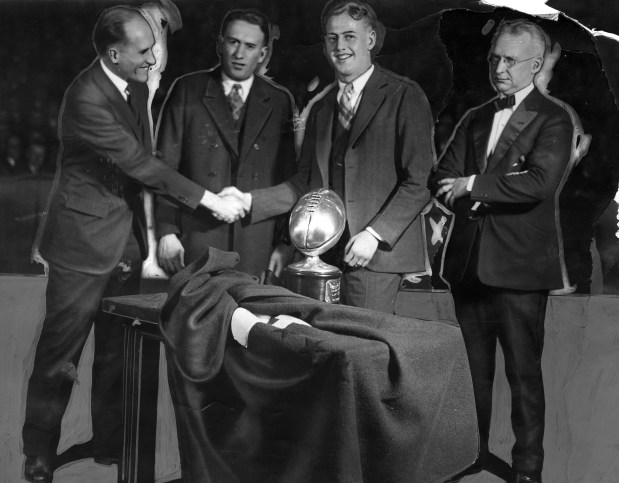“What football player of the Big Ten is of greatest value to his team?”
In October 1924, Chicago Daily Tribune sports writer Harvey Woodruff wrote that the newspaper had “authorized” him to answer that question.
The player chosen would receive “an award symbolic of the honor bestowed,” Woodruff wrote. “It will be a cup, trophy, emblem or something else of value which will always be a reminder of his successful days on the gridiron.”
According to Woodruff, Carl M. Green had suggested the idea for the award to him. Green, a Michigan alumnus and former director of advertising at Chalmers Motor Company, had originated the Chalmers Award in Major League Baseball.
Announced on March 25, 1910, the Chalmers Award promised a Chalmers Model 30, one of the most luxurious cars of the time, to the player with the major leagues’ highest batting average that season. The award, presented annually until 1914, marked the beginning not only of recognizing individual excellence — it led to the development of baseball’s Most Valuable Player award — but also of merging sports and commercial interests.
Originally intended for the “player of greatest value to his team” and not necessarily the “greatest player,” the Tribune’s football trophy was “to give the self-effacing chap who labors only for teamwork and team success an opportunity as nearly equal as possible to the ball carrier out in the limelight,” Woodruff wrote. “Success of the stars is made possible by the work seldom revealed to the spectators, of men who are blocking opponents and offering interference.”
The Tribune hoped the annual award, which preceded the Heisman Trophy by 11 years, would “become a much sought honor surpassing any now possible for these hard-working gridiron heroes whose efforts afford pleasure to so many thousand people.”
In the initial announcement of the award, Woodruff wrote that “everything counts” with regard to qualifications for winning. Listed items for consideration of a player’s value included “his sportsmanship, his influence among his fellows, his amenity to discipline and to qualities apart from physical prowess, although the latter, of course, in such a strenuous sport as football, is an elementary essential.”
One hundred years later, the Chicago Tribune Silver Football — now presented in partnership with the Union League Club of Chicago — remains one of the highest honors a Big Ten player can receive. The list of winners includes future Pro Football Hall of Famers and Super Bowl MVPs along with others less remembered in the sport’s annals.
And while the method of selection has evolved over the years, the Silver Football continues, in Woodruff’s words, “to give to one player each season supreme honor, honor far greater in its meaning than the mere title of ‘greatest football player.’”
Choosing a winner
Harvey Woodruff was born in Brazil, Ind., and his family relocated to Chicago when he was school age. He graduated in 1894 from West Division High School (later renamed McKinley and now the site of Chicago Bulls College Prep).
While a student at the University of Chicago, Woodruff wrote for the Chicago Times-Herald, eventually leaving school in 1897 for newspaper work and getting promoted soon after to sports editor. Woodruff spent three years as sports editor of the Chicago Record before joining the Tribune in February 1901 as a copy reader and sports writer.
Woodruff left the Tribune in 1903 to become secretary and treasurer of the Western Jockey Club, where he served for five years before returning to the Tribune as sports editor in 1908. When he stepped down from that role in 1920, Woodruff became the “In the Wake of the News” columnist and a special writer for then-sports editor Frank Smith.
The new Big Ten football award was one of Woodruff’s special projects. Through a series of articles published in the Tribune from October through early December of 1924, he worked out the details of the award, including how the player would be picked as well as feedback he’d received.
For the first season, Woodruff would make the selection based on the opinions and expressed choices of Big Ten coaches, game officials and Commissioner John L. Griffith. He also invited fans to write to the Tribune with suggestions of “any notable playing or incidents which make a player eligible for the honor.”
Though the award was received enthusiastically by fans, former players and coaches, according to Woodruff, he received some feedback that Big Ten coaches would not make their selections fairly. Woodruff disagreed.
“The writer has such a high regard for the men coaching football in the conference that he does not believe this objection would hold,” he wrote a week after the award’s announcement. “In outlining the plan, however, any such possibility was removed for another reason.”
Each coach was asked to make two choices: one from his own team and one from another team. Woodruff believed if a name appeared on enough ballots, it would balance a coach choosing his own player. The player on the coach’s team received one point and the player from an opposing team received two points.
Game officials were asked to name a first and second choice, who received two points and one point, respectively. Ballots submitted by Griffith and Woodruff himself were tabulated using the same system as the officials.
Choosing the trophy
By late November, the Tribune award had grown in popularity. As the end of the football season approached, Woodruff wrote that interest in the award had “reached its greatest height” based on “the many letters received urging claims of the various candidates with reasons therefore.”
Woodruff quoted Griffith, Michigan athletic director Fielding H. Yost, Ohio State coach J.W. Wilce and Northwestern coach Glenn Thistlethwaite in support of the award’s creation and mission. One conference official, Joe Magidsohn, was quoted as saying: “Very often only the men carrying the ball are considered the outstanding stars of their respective teams. Your plan undoubtedly will in course of time educate the public to the fact that carrying the ball is in almost all cases made possible by the hard word of other men on the team, which work does not stand out so prominently.”
Woodruff again reminded readers that the purpose of the award was “to encourage team play as contrasted with lone individual brilliancy.” He expressed hope that the award would not be a strictly offensive recognition but that in future years a defensive player would be seen as worthy of winning.
Over the six weeks after the award was announced, two finalists had emerged: Northwestern halfback and Rockford native Ralph Baker and Illinois halfback Red Grange, who grew up in Wheaton. Baker had spent his freshman year at Illinois with Grange before transferring to Northwestern in 1924.
In December, a description of the trophy was finally released.
“The Big Ten player of greatest value to his team in 1924 will receive a sterling silver football, about two-thirds the size of the regulation oval used on the gridiron,” Woodruff wrote. “This silver football, whose design is a replica of the outdoor pigskin, will rest at an angle on an artistic ebony pedestal.”
The silver football was chosen instead of an automobile because of the cost of maintenance. A watch, diamond fobs, diamond studs and diamond links also were considered and rejected, as was a monetary reward.
“Winning this trophy will be a great honor,” Woodruff explained. “Football players, who bring hundreds of thousands of dollars into college athletic treasuries, are unrewarded in any material way. That is proper. It is what makes college football what it is. There is no intention to reward them. This trophy guards against that.”

Ahead of the announcement of the winner, the trophy was on display in the Madison Street window of the Tribune office at Madison and Dearborn.
On Dec. 21, 1924, Grange was announced as the inaugural Chicago Tribune Silver Football winner. He was the opposing-team pick of six of the nine other coaches and received 23 points in all to Baker’s 18.
The voting system has changed over the years, and today the winner is selected solely by the Big Ten’s head coaches. Each coach submits a first and second choice and cannot vote for players on his own team. A first-place vote is worth two points and a second-place vote gets one point.

Initially a player who won the Silver Football was deemed ineligible to win it the next season, but in 1952 and ’53, Minnesota halfback Paul Giel became the first of five two-time winners. Thirteen Silver Football winners also won the Heisman Trophy, including inaugural Heisman winner Jay Berwanger of the University of Chicago in 1935.
Ohio State has the most winners with 23, and Michigan is right behind with 19. The two archrivals have combined to produce the last six winners and 12 in the last 15 years. The award was shared by two players in 2009 (Penn State quarterback Daryll Clark and Michigan defensive end Brandon Graham) and 2016 (Ohio State quarterback J.T. Barrett and Penn State running back Saquon Barkley).
Since the Silver Football’s inception, 40 running backs or halfbacks have won the award, with quarterbacks second with 35 winners. Despite Woodruff’s initial hope the award would recognize both offensive and defensive brilliance, only eight defensive players have received the Silver Football in its 100-year history.



